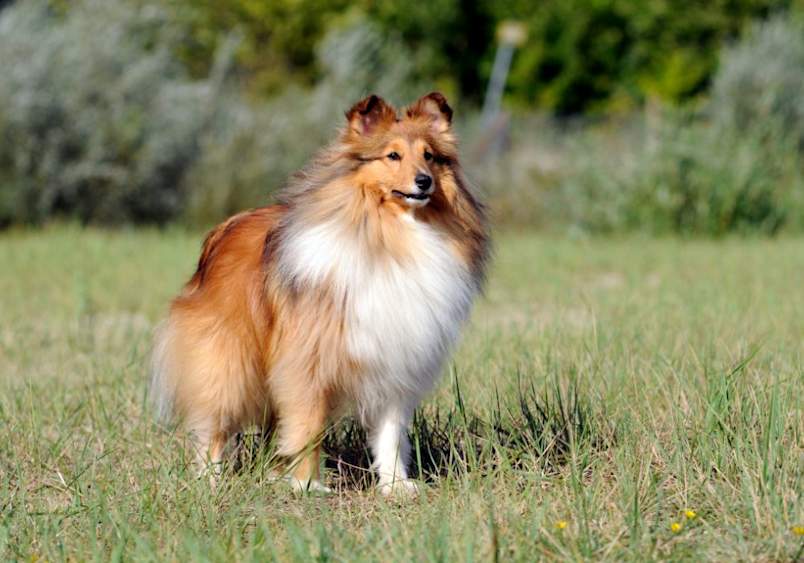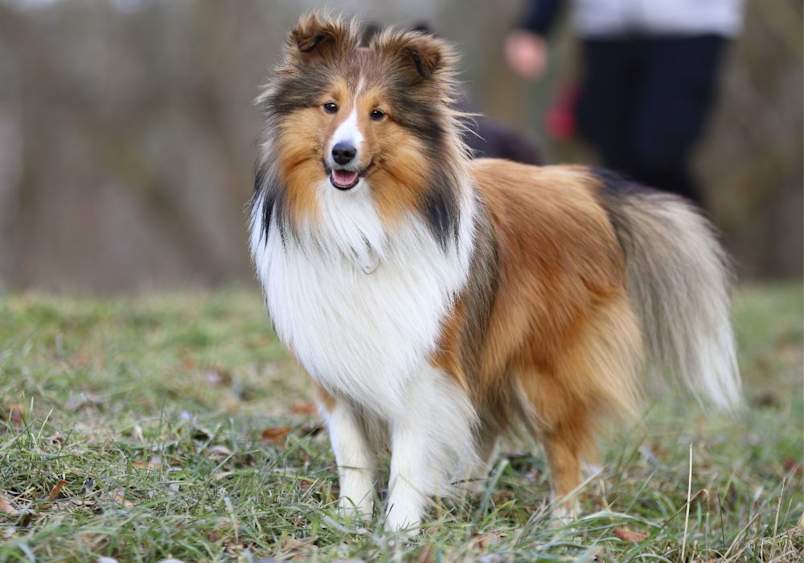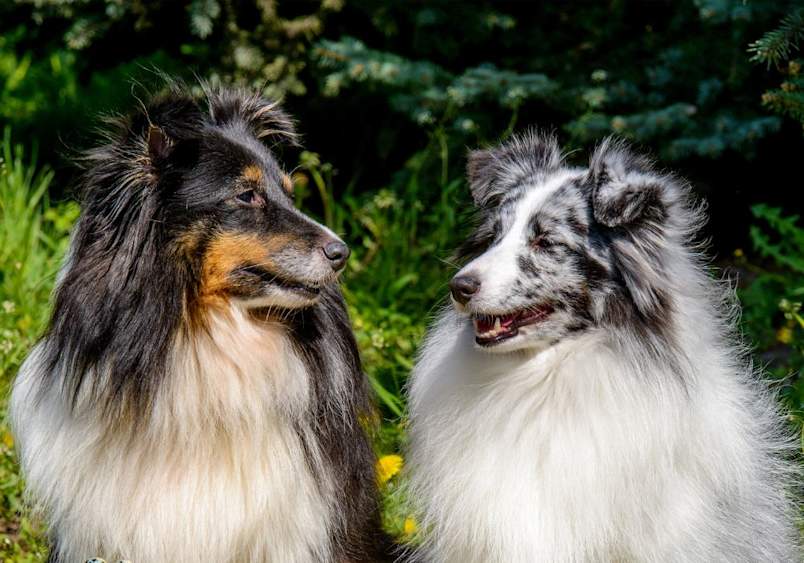
Have you ever met a Shetland Sheepdog? With their fox-like face, bright eyes, and what seems like a permanent smile, these charming dogs (affectionately known as Shelties) are sure to capture your heart. If you're looking for an intelligent, devoted companion who packs all the herding ability of larger dogs into a more manageable size, you might have just found your perfect match. These incredible dogs have become one of America's beloved breeds, and for good reason!
Whether you're thinking about bringing a Sheltie into your family or you're already sharing your life with one of these remarkable dogs, we're here to help you understand everything about their unique traits and needs. From their gorgeous double coat to their impressive agility skills, your Sheltie will bring you a delightful blend of beauty, brains, and unwavering loyalty.
Quick Sheltie Facts
Name: Shetland Sheepdog, Sheltie, Shelty, Shetland Sheep Dog
Origin: Shetland Islands, Scotland
Size: 13-16 inches tall and 15-25 pounds
Lifespan: 12-15 years
Appearance: Long, thick double coat in sable, black, or blue merle with white markings
Temperament: Intelligent, gentle, and loyal
Compatibility: Excellent with families and children when properly trained
Intelligence: Ranked among the most intelligent dog breeds
Exercise & Energy: High energy, requiring daily physical and mental stimulation
Grooming Needs: Extensive grooming required with regular brushing and professional care
Training: Highly trainable and eager to learn
Health: Several breed-specific health concerns to monitor
Highlights: Athletic, devoted family companion with herding instincts
What Makes Shetland Sheepdogs Special?
Natural athletes: Shelties excel in agility competitions and dog sports, combining their remarkable speed and intelligence to become top performers in these activities.
Devoted family guardians: These loyal dogs form incredibly strong bonds with their families, showing unwavering devotion while maintaining a gentle, protective nature.
Highly intelligent workers: Ranking among the smartest dog breeds, Shelties love learning new tasks and excel at problem-solving, making training a rewarding experience.
Perfect suburban companions: These adaptable dogs thrive in homes with yards where they can exercise their herding instincts while enjoying family life.
Excellent with children: When properly trained, Shelties make gentle and patient playmates for kids, watching over them with their natural herding instinct.
Wonderful watchdogs: Their alert nature and keen intelligence make them excellent watchdogs without being aggressive, always ready to notify you of visitors.
Weather-resistant beauty: Their stunning double coat not only makes them beautiful but also helps them stay comfortable in various weather conditions.

Shelties Appearance
The Shetland Sheepdog's striking appearance often draws admiring glances with its elegant, flowing coat and alert expression. These beautiful dogs showcase the perfect balance of refinement and sturdiness, embodying their heritage as working dogs in a smaller package. With their distinctive coat and delicate features, Shelties often turn heads during neighborhood walks or at the dog park.
Shetland Sheepdog Size
Adult Shelties typically stand between 13-16 inches at the shoulder and weigh between 15-25 pounds, making them an ideal size for most homes. Their compact build allows them to be agile and quick while remaining small enough to be comfortable apartment dwellers when given proper exercise. Despite their smaller stature, these dogs maintain the grace and athleticism of their herding heritage.
Sheltie Dog Coat and Colors
The Shetland Sheepdog's double coat is one of their most distinctive features. Their outer coat consists of long, straight hair, while their undercoat is short, dense, and soft. Shelties come in several beautiful color variations including sable (ranging from golden to mahogany), black with white and tan markings, blue merle with black mottling, and bi-black or tri-colored patterns. Each color variation maintains the breed's characteristic ruff around the neck and feathering on the legs and tail.
Shelty Temperament
Shetland Sheepdog personality traits make them wonderful companions for the right families. These intelligent and sensitive dogs form strong bonds with their people and show remarkable loyalty. While they may be reserved with strangers, Shelties are deeply devoted to their families and show great enthusiasm for activities with their loved ones.
Shetland Sheepdog Personality
The Sheltie's temperament is a delightful mix of intelligence, sensitivity, and energy. These dogs are known for their keen ability to read their owners' emotions and respond accordingly. They're naturally alert and make excellent watchdogs, though their tendency to bark requires early training. Their herding heritage shows in their attention to moving objects and desire to keep their "flock" together.
What are Shelties Like with Children and Family?
Shetland Sheepdogs can make excellent family pets when properly trained and socialized. Their gentle nature and medium size make them good companions for children who understand how to interact respectfully with dogs. Early training is beneficial to prevent herding behaviors like nipping at heels, but with proper guidance, Shelties often become devoted family guardians and playmates.
Do Shetland Sheep Dogs Get Along with Other Animals?
Most Shelties get along well with other pets, especially when raised together. If you're planning to add a new pet to your household, proper introductions are key to establishing harmonious relationships. Their herding instincts may lead them to try organizing other animals, but they generally show good manners with both dogs and cats. Early socialization also helps ensure positive relationships with other household pets and neighborhood animals.
Caring for Your Sheltie
Caring for a Shetland Sheepdog requires dedication to their physical and mental well-being. These intelligent and active dogs need regular exercise, mental stimulation, and consistent grooming to stay healthy and happy. Understanding their specific needs helps ensure they remain well-adjusted family members.
Importance of Grooming a Shetland Sheepdog
The beautiful double coat of a Sheltie requires regular maintenance to stay healthy and mat-free. Weekly brushing is essential, with more frequent grooming during seasonal shedding periods. Just as their coat needs consistent care, a regular teeth-brushing routine is vital for maintaining your Sheltie's overall health. Professional grooming every 6-8 weeks helps maintain the coat's condition and manage shedding. Special attention should be paid to the thick ruff around the neck and the feathering on legs and tail where tangles commonly occur.
Training Your Sheltie
Shetland Sheepdogs excel in training thanks to their high intelligence and eager-to-please nature. They respond best to positive reinforcement methods and can learn complex commands and tricks. Early socialization can help prevent excessive shyness or barking. These dogs particularly enjoy agility training, herding trials, and other dog sports that challenge both their minds and bodies.
How Much Space Does a Shetland Sheepdog Need?
While Shelties can adapt to apartment living if given sufficient exercise, they thrive in homes with fenced yards where they can run safely. They need regular daily exercise, both physical and mental, to prevent boredom and associated behavioral issues. A combination of walks, play sessions, and training activities helps keep them well-balanced and happy.
Feeding Your New Sheltie Dog
A high-quality diet appropriate for their size and activity level is a must for Shetland Sheepdogs. While your Sheltie's main diet should be dog food, you might occasionally want to share safe human foods as treats, but always in moderation. Also remember that portion control is important as these dogs can become overweight if overfed. Adult Shelties typically need 2-3 small meals daily, with amounts adjusted based on age, activity level, and overall health.

Shetland Sheepdog Health Issues and How to Manage
While Shetland Sheepdogs are generally healthy dogs, they can be prone to certain genetic health conditions. Regular veterinary check-ups and preventive care help ensure early detection and management of potential issues.
What are the Common Health Issues of Shetland Sheepdog?
Von Willebrand's Disease
Von Willebrand's Disease, which is an inherited blood clotting disorder, can cause excessive bleeding from minor injuries or during surgery in Shetland Sheepdogs. Similar to hemophilia in humans, affected Shelties may experience prolonged bleeding from small cuts, dental procedures, or during routine surgeries. Regular testing and awareness of this condition are essential for safe veterinary care, and your vet should be informed about your Sheltie's status before any surgical procedures.
Multiple Drug Sensitivities
Some Shelties carry a genetic mutation that makes them sensitive to certain medications, including common drugs used in veterinary medicine. This condition, known as MDR1 gene mutation, can cause severe neurological reactions to various medications that are typically safe for other dogs. Genetic testing can identify affected dogs early in life, and working closely with your veterinarian to choose safe alternative medications ensures your Sheltie receives appropriate treatment without risks.
Dermatomyositis
This inherited skin condition, also known as Sheltie Skin Syndrome, typically appears in young dogs and can cause hair loss and muscle inflammation, particularly around the face, ears, and legs. Affecting Shelties between 4-6 months of age, this condition can range from mild to severe, with some dogs experiencing muscle weakness along with skin lesions. Early detection and proper management through medication and environmental modifications are important for affected dogs, and regular vet check-ups help monitor the condition's progression.
Eye Conditions
Shelties can be prone to various eye problems, including Collie Eye Anomaly and Progressive Retinal Atrophy, which can impact their vision and quality of life. While dogs naturally see the world differently than humans, certain conditions can further impact their vision. Collie Eye Anomaly is present from birth and affects the development of the eye, while Progressive Retinal Atrophy causes gradual vision loss over time.
Regular eye examinations by a veterinary ophthalmologist help monitor eye health and catch potential issues early, allowing for better management of these conditions throughout your Sheltie's life.
Investing in Dog Insurance for Your Sheltie Puppies
Protect your Sheltie's vibrant spirit and health with pet insurance that understands their unique needs. Shetland Sheepdogs, with their remarkable intelligence and athletic abilities, can face several breed-specific health challenges throughout their lives, from Von Willebrand's Disease to eye conditions. This is why dog insurance for Shelties often comes at a higher premium compared to mixed breeds – these beautiful herding dogs are more likely to need specialized care for their inherited conditions.
Get a dog insurance quote that covers the breed-specific conditions your Sheltie might encounter. The optimal time to secure insurance is when your Sheltie is a bouncing, healthy puppy, before any genetic conditions surface, as pre-existing conditions aren’t covered.
Insuring your Sheltie early allows you to focus on the fun stuff – agility trials, family outings, and all the joys of having a Sheltie – knowing you're prepared for unexpected veterinary costs. As a breed with a long history of herding in the wild Scottish terrain, Shelties are resilient but this doesn't eliminate the need for careful attention to their health and potential breed-specific issues. It's important to balance this inherent hardiness with proactive healthcare to ensure a long and healthy life.
The History of Shelties
The Shetland Sheepdog's story begins in the rugged Shetland Islands of Scotland, where these dogs were developed to herd sheep, ponies, and poultry. Originally bred to be smaller than their Rough Collie cousins to suit the islands' smaller livestock and reduce feeding costs, Shelties evolved into the distinct breed we know today.
These hardy dogs worked alongside farmers in the harsh conditions of the Shetland Islands, developing their intelligence, agility, and weather-resistant coat. While they share some ancestry with Rough Collies, Shelties evolved as a distinct breed with their own unique characteristics and a heritage deeply rooted in the Shetland Isles.
Finding a Shetland Sheepdog Near You
Ready to welcome a Sheltie into your life? Your first step should be the American Shetland Sheepdog Association's breeder referral network. These certified breeders commit to a strict Code of Ethics, ensuring proper care and lifetime support for their puppies. Never purchase from pet stores or online retailers offering quick shipping – these typically source from puppy mills where profit trumps health and well-being.
A responsible breeder should readily provide written health documentation, including VetGen testing for Von Willebrand's Disease, OFA certifications confirming parents are free from Multiple Drug Sensitivity and hip dysplasia, and CERF eye clearances from the previous year. For blue merle Shelties, insist on hearing test results. Be wary of breeders who claim their lines are "problem-free" or only offer basic vet checks – genetic health testing documentation is non-negotiable. Look elsewhere if a breeder hesitates to share these records or show you their facilities.
Don't overlook the rewarding option of adopting through Sheltie rescue organizations. Adult dogs often come with known personalities and established health histories, plus you're giving a deserving dog a second chance. Whether choosing a puppy or adult, ensure you receive a detailed contract outlining health guarantees and both parties' responsibilities. Schedule a veterinary examination immediately after bringing your new friend home. Remember, with Shelties living 13-15 years, taking time to find the right match from a reputable source isn't just about getting a dog – it's about the long, joyful journey you’ll start together.
Shetland Sheepdog FAQs
Are Shelties good apartment dogs?
Shetland Sheepdogs can adapt to apartment living if given sufficient exercise and training to manage their barking tendencies. They need regular walks and mental stimulation regardless of living space.
How much exercise does a Sheltie need?
Shelties require at least 30-60 minutes of daily exercise, combining walks, play sessions, and mental stimulation activities. They excel in dog sports like agility and obedience training.
Do Shetland Sheepdogs bark a lot?
Yes, Shelties tend to be vocal dogs in various ways. They not only bark but may also whine to communicate their needs, which is common among herding breeds. Early training can help manage excessive barking, but potential owners should be prepared for a naturally talkative companion.
Are Shelties good with children?
With proper training and socialization, Shetland Sheepdogs make excellent family dogs. They need guidance to prevent herding behaviors, but their gentle nature and intelligence make them wonderful companions for children.
How often do Shelties need grooming?
Shetland Sheepdogs need weekly brushing at minimum, with more frequent grooming during shedding seasons. Professional grooming every 6-8 weeks helps maintain their coat health.
What's the difference between a Sheltie and a miniature Collie?
While they may look similar, the Shetland Sheepdog is a distinct breed from the Collie, with its own unique size, temperament, and heritage. Shelties are more reserved with unfamiliar faces, exhibiting a cautious nature. They are deeply empathetic and respond best to positive reinforcement, easily upset by harsh corrections. While Collies may be more overtly demonstrative in their affection, Shelties express their intense loyalty through quiet devotion. If a Collie is the outgoing social butterfly, a Sheltie is the devoted confidant, offering loyalty and quiet companionship.